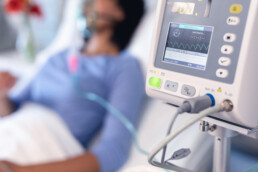Can reducing surgical readmissions be as simple as brushing your teeth?
Today we are targeting the surgical patient population for a simple readmissions intervention: tooth brushing.
Improving oral hygiene prior to surgery is an emerging recommendation to reduce the risk of post-operative infections. Problems with teeth or gums can be a major source of bacteria that can enter the bloodstream or lungs causing pneumonia or sepsis, both of which are leading diagnoses related to readmissions.
There is evidence that patients undergoing cardiovascular surgery and major cancer surgery benefit from preoperative oral care. However, a clean mouth prior to surgery is good for all patients. Do your patients know they can brush their teeth the morning of surgery, even though they may be NPO?
Postoperatively, good oral hygiene continues to protect patients from pneumonia, yet studies show that 70% of hospitalized patients do not receive adequate oral hygiene. For more information about improving oral care for patients, read this guide about the problem and a solution utilizing a nurse-led hospital-acquired pneumonia program that proved that oral care is much more than a comfort measure.
Just for fun: Want a tool to engage pre-operative patients in upping their brushing game? Brush DJ is a fun app that uses music and buzzes every 30 seconds to change sides and a round of applause when you finish after 2 minutes of brushing.
If your organization is ready to get serious about reducing readmissions, review the Cynosure Readmissions Discovery Tool to see where there are opportunities for improvement beyond oral health in your organization.
Reduce Readmissions by Involving Pharmacists in your Medication Reconciliation Process
Did you know, an easy way to reduce readmissions is by getting pharmacists involved in the medication reconciliation process?
Studies have demonstrated that up to 20% of readmissions are due to medication-related problems (MRPs) and that 70% of these problems are preventable if pharmacy staff are part of the discharge process.
In fact, Duke University Hospital published results of a pharmacist-led discharge medication reconciliation process with the aim of reducing discharge medication discrepancies and unplanned readmissions. 67% of the patients needed an intervention that was discovered by the pharmacist, even though the provider already completed a preliminary med rec.
So, should your organization start?
4 Steps to Reduce Readmissions through Medication Reconciliation
- Review the discharge medication reconciliation process using the Med Rec Discovery Tool.
- Ask several clinicians who are currently responsible for discharge med rec to describe the process and compare the discovery tool. Chances are that if nursing staff or providers are carrying out this task independently, there is room for improvement.
- Engage your pharmacy staff to identify strategies to implement in closing gaps discovered through your review.
- Test! Select one pharmacy-driven strategy to test. Start small with a segmented group of patients. Use your data to determine which small group of patients to prioritize for the first tests of change. This small group of patients in the initial test of change might be identified by age, diagnosis, number of medications, drug classifications, or patients on two or more drugs of the same class for review to keep the pharmacist discharge med rec manageable.
We always recommend testing small groups, reviewing the results, noticing any improvements or learning opportunities, and continuing until you find the best solution to serve your patients. Even 1 avoided readmission is making strides toward a safer patient population because of your efforts.
Importance of Self-Assessment to Identify Gaps in Sepsis Protocols
We sat down with Cynosure Health Improvement Advisor, Maryanne Whitney, to get her take on the self-assessment of sepsis protocols and advice she has for hospitals who are looking to improve. Let’s dive in.
How does self-assessment improve sepsis mortality?
A self-assessment can highlight strengths and identify gaps or areas that may be an improvement opportunity. These improvement opportunities can lead to lives saved through earlier detection methods or improved intervention strategies.
What information will garner the most buy-in for change?
Data will often garner buy-in. Self-assessments and discovery tools are "real" data of an individual facility's sepsis programs and can serve as a "reality check." During the self-assessment, we look at what we know needs to be happening for patients with sepsis vs. what is actually happening. This realization in an organization can be a very powerful motivator for change.
How can physicians or leadership be more involved?
Leaders need to be involved as sponsors of a sepsis program, ensure that sepsis mortality reduction is a strategic goal, and mitigate barriers for the teams. Physicians are critical members and leaders in a sepsis program. Without a physician champion for sepsis, change and improvement in sepsis protocols is difficult.
If you’re ready to review your sepsis protocols and make a plan for improvement with a self-assessment, assess your current practices using the Cynosure Sepsis Discovery Tool.
Together we can improve health care further, faster.
Reducing Readmissions for Patients with Sepsis
Each year, more than 19 million individuals develop sepsis, defined as a life-threatening acute organ dysfunction secondary to infection. Approximately 14 million survive to hospital discharge, and their prognosis varies.
Of the survivors, 50% fully recover, 1/3 die within one year of discharge, and about 1/6 have ongoing impairments.
These impairments include functional/mobility issues, mental health issues, and exacerbation or rapid decline in chronic conditions. This puts patients who have experienced sepsis at increased risk for hospital readmission.
Despite the challenges facing patients following hospitalization with sepsis, guidance for healthcare professionals for providing optimal post-hospital sepsis care is not well established.
This article released in JAMA examined ways to enhance recovery after sepsis. The article suggests that post-hospital sepsis care should focus on:
- Identification of new physical, mental, and cognitive problems and referrals for appropriate treatment.
- Review and adjustment of long-term medications.
- Evaluation for treatable conditions that commonly result in hospitalization, such as infection, heart failure, renal failure, and aspiration.
- Consideration of palliative care for patients with poor or declining health prior to sepsis who experience further deterioration after sepsis.
If you’re looking to improve your sepsis protocols and reduce your readmissions, review the Cynosure Sepsis Discovery Tool and the Cynosure Readmissions Discovery Tool to find areas of opportunity for improvement. Because together we can improve health care further, faster.
Why Improve Sepsis Protocols and Detection Methods
Written in collaboration by Sepsis Alliance and Cynosure
The question of why might be something you hear throughout your organization. Maybe what follows is that sepsis protocols are “good enough” or that there isn’t bandwidth to improve.
The truth of the matter is, sepsis continues to be a public health crisis that needs our attention. In fact, more than 1.7 million people in the U.S. are diagnosed with sepsis each year. In the United States, sepsis takes a life every two minutes - this is more than opioid overdoses, breast cancer, and prostate cancer combined.
If those facts aren’t enough, sepsis is the number one cause of hospital readmissions, costing more than $3.5 billion each year.
As Sepsis Awareness Month begins, we ask that you to take another look at your sepsis protocols and detection methods. We encourage you to see if there are any obvious areas for improvement. Improving our sepsis protocols and detection methods can (and will) save lives.
More about Sepsis Alliance
Sepsis Alliance is the leading sepsis organization in the U.S., working in all 50 states to save lives and reduce suffering from sepsis. The organization was founded in 2007 by Dr. Carl Flatley, whose daughter Erin died unnecessarily of sepsis when she was 23 years old. Sepsis awareness can and does save lives, yet only 63% of American adults have ever heard the word sepsis.
The Sepsis Alliance team works to produce information for both healthcare professionals and the public to elevate sepsis care with education, resources, and networking.
We encourage you to register for an upcoming educational event - the Sepsis Alliance Summit! Join Sepsis Alliance for a FREE, virtual conference on sepsis held on September 27 and 28, 2023. Sepsis Alliance Summit features two days of virtual expert-led sepsis content and opportunities to engage with other healthcare professionals. Free continuing nursing education credits will also be available!
Where to Start to Improve your Sepsis Protocols and Detection Methods
Sepsis Awareness Month is a great time to begin to examine your current efforts and gain ideas and inspiration for further improvements. As you begin to take further action to improve awareness of sepsis mortality and morbidity, a great first step is to assess your current practices using the Cynosure Sepsis Discovery Tool to provide a real time evaluation of your current processes and by reviewing the 2023 Cynosure Sepsis Safe Hospital Self-Assessment.
Next, connect with the right information and tools to support your efforts. Sepsis Alliance has released a Sepsis Awareness Month tool kit to help inspire your Sepsis Awareness month activities.
Then, join us as we highlight hospital best practices in our Cynosure Sepsis “How to” Series:
- Sepsis Screening & Implementing an Hour One Bundle will be featured on September 21 @ 1:00 pm EST register here
- Handoff checklists and Post Sepsis Support Groups will be featured on September 28 @ 1:00 pm EST register here
Now is the time to get started! You can learn more about sepsis and find other ways to get involved at sepsis.org.
Emerging Problems in the US Health Care System: 3 Ways to Mitigate Diagnostic Errors in Medicine
Diagnostic harm and diagnostic improvement have become buzzwords in patient safety and risk management and with good reason. A recent study by Johns Hopkins showed that medical providers misdiagnose 11% of the time, but this rate differs widely from 1.5% diagnostic error rate for heart attacks to 62% diagnostic error rate for spinal abscesses. This is cause for considerable problems in the US health care system, especially when it’s already feeling fragile post-pandemic.
The good news is that we in the medical community recognize a problem, and we’re ready to do something about it. So, how do we mitigate diagnostic harm and help reduce diagnostic errors in medicine?
1. Develop Tactics to Identify and Learn from Diagnostic Errors or Near Misses
We have so much data at our fingertips, and we can use this to learn from or identify any diagnostic errors. Here are a few places you can find a diagnostic error or a near miss:
- Use data: Review adverse event reports or any medical malpractice data. Gaining knowledge and learning from the data at hand helps ensure history isn’t repeated.
- Learn from your patients: Review patient complaint logs. They can tell you so much about the patient’s feelings, where a diagnostic error might have happened, and what steps could help in the future.
Now we know where to find them, but what do we do with it? We suggest a regular cadence of review of these data points. Gather a team that will review together and then strategize different ways to mitigate this instance in the future.
2. More Effective Teamwork during Diagnostic Process
A lot of times, more eyes, more ears, more brains, and more experiences coming together can create a better overall diagnosis for a patient. We suggest having a process where multiple health care professionals are involved with a diagnosis, especially a more difficult case or one you’ve rarely seen. No matter how many years of experience you have, there can always be something missed or symptoms you haven’t been presented with before that can cause a misdiagnosis.
A great place to start is working with your Quality Director to create a small test of change in how to gather a diagnostic team.
3. Enhancing Health Care Professional Education and Training Around Diagnostic Process
More training and education is usually a great answer when there’s a problem to tackle. When it comes to something like diagnostic accuracy, a refresher course is a great place to start. Thankfully, ARHQ’s TeamSTEPPS Diagnostic Improvement Course is developed to improve diagnostic accuracy for individuals or large groups. For more information on the course, please go here.
At Cynosure, we have many team members that are certified TeamSTEPPS trainers and know the ins and outs of the TeamSTEPPS Diagnostic Improvement Course. If your organization is wanting to implement this vital training, but isn’t sure how to get started, please reach out to us today.
Care Transitions: Improving Discharge Phone Call Outcomes
When it comes to discharge phone calls, we often encounter the "my patient didn't answer" obstacle. Such a vital piece of the care puzzle shouldn't get bypassed because our team was sent to voicemail. This article outlines a few ways to increase the chances of patients answering this important phone call.
Tactics to Increase Answering of Discharge Phone Call
1) Tell the patient in advance that you will call and share the purpose of the call or details you might discuss
2) Schedule a convenient time for the call
3) Ask if a significant family member or caregiver can be present and make sure the scheduled call works for them
4) Create reminder magnets with the date and phone number you'll be calling from
5) Put a post it note with the date and phone number on the top of the discharge papers
Bonus: Telling the patient and/or caregiver the phone number you'll be calling from ensures they have a callback number in case they miss your call or they need help prior to the follow up
Example: What can I do to Improve Care Transitions in 1 Week?
Let's walk through an example of telling the patient in advance about the discharge phone call, scheduling a day and time for the call, and what number they will receive the call from.
Monday: Review the QI Project Planning Worksheet that will guide you through the steps of planning for a Small Test Of Change (STOC).
Tuesday: Huddle with your hospital team that will be involved in testing something new and explain the expectations.
Wednesday: Test one change idea with one or several discharges that day. Huddle with your team after. How did it go? What would make it easier? What challenges did you encounter? What will you do differently with the next patient, tomorrow?
Thursday: Try the test again with modifications based upon Wednesday’s experience.
Friday: Call the patient or family caregiver that you tested advance notification intervention with. Did they pick up the call? If yes, what made them answer? If no, reflect on your STOC conducted on Wednesday. Will you adapt or abandon the change idea? Will you try adding a post it note with the date, time and phone number you will be calling from?
All this to say, discharge phone calls may be low-hanging fruit to capitalize on that can do a great deal to help decrease your readmissions and continually better serve your patient population. If you’re looking for more ways to improve your Care Transitions, reach out and we’d be happy to talk strategy with you.
Free Social Drivers/Determinants of Health Online Training
Are you or your team left feeling uncertain about how to screen for social drivers/determinants of health (SDOH)? We understand that it can be tricky to navigate such sensitive topics. And if you aren’t sure where to start, determining what screening tool to use can be overwhelming.
Thankfully, we have some resources that can help.
The Cynosure Learning & Improvement Connection (CLIC) hub has several resources around SDOH, and they are all completely free. These short but thorough courses will answer your pressing questions, bring new light to what might feel like daunting tasks, and give you and your team newfound confidence regarding SDOH screening practices.
Social Drivers/Determinants of Health Online Training Courses Offered by CLIC hub
- Getting Started with Screening for Social Drivers of Health – Students will learn through video modules and document downloads the varying SDOH screening tools available, their pros and cons, and determine which tool makes the most sense for their organization. The course should take less than 10 minutes to complete, including reading through source materials.
- SDOH Training: Creating a Trusting Environment – In this short course, students explore the best ways to navigate tough questions like “Do you have a safe place to sleep tonight?” and “Can you cover your electric bill this month?” These questions can feel so intrusive but are often critical to our patient’s well-being. Knowing the answers often lend us to a better overall medical outcome. It should take no longer than 10 minutes to review this course and its source materials.
Why Get CPHQ Certified? And Other Answered Questions about CPHQ Certification
As health care professionals, enhancing our skills and improving patient safety outcomes is always on our minds. But what if beyond only a patient to patient basis, you could influence global change and improvement at the organizational level? This is what the quality manager or director can do. If you have these dreams, it’s time for a serious look at career advancement opportunities.
So how do you land a position like that? Even with a stacked resume featuring glowing recommendations and advanced skillset, it can be difficult to move positions. A great way to stand out amongst your peers is to prove your commitment to quality improvement through the Certified Professional of Healthcare Quality (CPHQ) accreditation.
This article will outline the benefits of the CPHQ certificate, how to get CPHQ certified, and ways to prepare for the CPHQ exam.
Benefits of CPHQ Certification
You might not be interested in taking on more education. But CPHQ certification can prove to have more positives than negatives in many situations. We’ve outlined a few reasons why getting CPHQ certified can benefit you.
Career Advancement
The CPHQ Certification shows commitment to your profession and the position you hope to hold. This helps set you apart from your competition and let’s others see you are ready for career advancement. In fact, according to National Association of Healthcare Quality (NAHQ) research, CPHQs work at higher levels of competency and hold higher job titles than non-CPHQ peers.
Advanced Knowledge in Health Care Quality
Beyond standing out for additional career opportunities, you will learn and prove advanced competencies in health care quality improvement. If you’re wanting to make an impact on patient safety and outcomes, this is how you can build on your current knowledge and know you’ll make a difference.
Enhance Credibility Amongst Peers and Network
With career advancement opportunities and advanced quality improvement knowledge, you will gain new respect and credibility from your peers and broader network. New opportunities can open up like being asked to sit on committees, attend specialized conferences, and more.
How to Get CPHQ Certified
Now you might be wondering “how do I actually get certified?” There is currently only one universally recognized accredited certification in healthcare quality, and that is the CPHQ certification through NAHQ.
You earn the CPHQ certificate by receiving a passing score (a 600 or better on a 200-800 scored scale) on the CPHQ exam. There are a few ways you can properly prepare for the exam to ensure a passing score and achieve the certificate.
Ways to Prepare for the CPHQ Exam
The best way to prepare for the CPHQ exam is finding an online prep course that sets you up for success. We recommend one with a comprehensive practice test, accessible and educational review courses, source materials, and sample questions or other exam-readiness indicators.
Finding the right way to prepare for the exam can be tricky, and sometimes when you find the option that fits all your needs, you could wind up spending hundreds and hundreds of dollars. And although for all the benefits, that cost might be worth it, we would like to offer a better solution.
The Preparing for CPHQ Exam: A Comprehensive Overview for Quality Professionals course on CLIC hub offers everything we recommend above with online, on-demand modules that you can access anytime you can spare a few moments in your ever-busy schedule.
Learn more about the course, modules, and what to expect to prepare for the CPHQ Exam here.
What social drivers of health (SDOH) questions should you ask?
Social drivers (also known as determinants) of health (SDOH) are the conditions in the environment where people live that affect quality of life, health outcomes, and risks. They include things like poverty, education level, access to health care (or lack thereof), etc. These factors impact our patients’ health before, during, and after any health care encounter. They also contribute to inequities and disparities in both care and outcomes. To truly deliver patient-centered care that accounts for each patients’ unique circumstances, we must consider how social drivers of health influence their lives.
One way to better understand any challenges your patients face – as well as assets in their communities, families, and homes – is to ask questions about these socio and economic factors. With this information, you can better partner with patients, their families, and care team members across your organization to design a care plan that addresses the non-medical factors that can play a huge role in the healing process.
The Centers for Medicare & Medicaid Services (CMS) worked with organizations across the country through the Accountable Health Communities Model to test approaches to asking patients about their health-related social needs (HRSNs). This effort led to the creation of the Accountable Health Communities Health-Related Social Needs Screening Tool, which includes 10 core questions about:
- Housing instability
- Food insecurity
- Transportation problems
- Utility help needs
- Interpersonal safety
Participants in this CMS Model tested different approaches to administering the screening tool and referring patients to available services to address their needs. These sites learned a lot. Hospitals who are now setting up their own processes to screen for and address SDOH can learn about strategies to make the business case for addressing SDOH, align payer and provider activities to address SDOH, expand and scale efforts to address SDOH, and more.
The CMS AHC HRSN screening tool is just one of many screening tools available to use. Whether you use the CMS AHC HRSN or another tool, any information you can gather about the non-medical factors your patients face will help you develop care plans that will more effectively promote healing and health.
Are you ready to take a deeper dive into how to navigating asking tricky SDOH questions? The free course SDOH Screening: Creating a Trusting Environment is exactly what you're looking for. Sign up today to help better address important SDOH questions with your patients.










